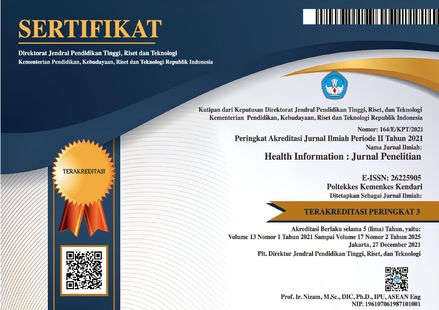The Relationship between the Use of Injectable Contraceptives and the Incidence of Amenorrhea in the Work Area of the Atari Jaya Community Health Center, Lalembuu District, Konawe Selatan Regency, 2015
DOI:
https://doi.org/10.36990/hijp.v10i1.58Keywords:
injection contraception, amenorrhoeaAbstract
Amenorrhoea is no occurrence of menstruation for 3 months or more in women who have experienced menstrual cycles. Some cases of amenorrhea can be found in injectable contraceptive acceptors. This is confirmed by the data from Southeast Sulawesi province that there are 284,784 and 201,627 (70.8%) among them experiencing amenorrhea. Objective: To find out whether there is a relationship between injectable contraception and the incidence of amenorrhea in the work area of Atari Jaya Health Center, Lalembuu District, South Konawe Regency in 2015. Research methods: Analytical research with design cross-study. The sample in this study amounted to 92 injectable contraceptive acceptors. This research uses an accidental sampling technique. Data analysis included univariate and bivariate analysis using the SPSS (Chi-Square test) program at the level of confidence = 0.05. Amenorrhoea is a complaint that is often felt in injectable contraceptive acceptors. Of the 92 injectable contraceptive acceptors who suffered secondary amenorrhoea, there were 59 (64.1%) acceptors while 33 (35.9%) acceptors did not suffer from secondary amenorrhoea. There is the relationship of injectable contraception with the incidence of amenorrhea. Conclusion: There is a correlation between injectable contraceptive use and the incidence of amenorrhea in the work area of Atari Jaya Community Health Center, Lalembuu Subdistrict, South Konawe Regency in 2015.
References
Arikunto S, 2006. Prosedur Penelitian Suatu Pendekatan Praktik, Ed Revisi VI, Penerbit PT Rineka Cipta, Jakarta.
Arikunto, S. 2010. Prosedur Penelitian Suatu Pendekatan Praktik. Jakarta: Pt Rineka Cipta.
Arum, Dns., Dan Sujuyatini. 2009. Pandangan Lengkap Pelayanan Kb Terkini.Jogyakarta: Nuha Medika.
Bazargani H.S.2006. Amenorrhea An Advantage Rather Than A Complication Of Depot Medroxy Progesterone Acetate Injectable Contraceptive, Antl; J. Pharnacol. 2 (6) 352-354.
Baziad, A. 2002. Kontrasepsi Hormonal. Jakarta. Bina Pustaka Sarwono Prawirohardjo
Bielak, K.M. 2008. Amenorea. Http//Medicine,Mediscape.Com (25 Januari 2015).
BKKBN,KB Suntik Paling di Gemari IbuIbu, 2013. http://m.kompas/news/readDiakses tanggal 1 Januari 2015
Boroditsky, Lera. 2000. “Metaphoric Structuring: Understanding Time 6 Through Spatial Metaphors,” Cognition, 75, 1-27.
Cunningham F.G. 2005 Obstetri Williams. Hartanto, H. (Eds). Edisi 21 Volume 2 Jakarta: EGC.Pp 1714- 7.
Depkkes. Ri. 2001. Kesehatan Reproduksi. Jakarta.
Hanafi, Hartanto. (2003). Keluarga Berencana Dan Kesehatan Reproduksi. Jakarta : Pustaka Sinar Harapan.
Hartanto, H. 2004. Keluarga Berencana dan Kontrasepsi. Jakarta: Pustaka Sinar Harapan.
Hartanto, H., 2009, Keluarga Berencana dan Kontrasepsi, Jakarta: Pustaka Sinar Harapan: 212-213.
Hatcher R.A, Trussell J, Nelson A.L. 2009. Contraceptive Technology. Edisi19. USA. Ardet Media Inc, pp:157-69;461-5
Heffner L.J. Dan Schust D.J. 2006. At A Glancesistem Reproduksi. Safitri S (Ed). Edisi 2. Jakarta; Penerbit Erlangga, Pp:68-71
Hillegas K.B. 2005. Gangguan Sistem Reproduksi Perempuan.Dalam: Price S.A Dan Wilson L.M. Patofisiologi: Konsep Klinis Proses-Proses Penyakit.Hartanto H. Dkk(Eds). Edisi 6.Volume 2. Jakarta:Penerbit Buku Kedokteran Egc, Pp:1280-7
Kaunitz A. 2001. Injectable Long-Acting Contraceptive. Clin Obstet Gynecol 44:73-91
Notoatmodjo.S. 2005. Metodologi Penelitian Kesehatan. Jakarta; Rineka Cipta.
Notoatmodjo, S. 2010. Metodologi Penelitian Kesehatan. Jakarta : Rineka Cipta
Pinem,S.2009. Kesehatan Reproduksi Dan Kontrasepsi. Jakarta:Trans Info Media.
Prawirohardjo, Sarwono. 2008. Ilmu Kandungan. Jakarta : Yayasan Bina Pustaka.
Riyanto, A. 2011. Aplikasi Metodologi Penelitian Kesehatan.Yogyakarta: Nuha Medika.
Saifuddin, A.B., B. Affandy, & Enriquito, R. LU., 2003, buku Panduan Praktis Pelayanan Kontrasepsi Edisi 1, Jakarta: Yayasan Bina Pustaka Prawirohardjo.
Sastroasmoro, Sudigdo & Sofyan Ismael. 1995. Dasar-Dasar Metodologi Penelitian Klinis. Jakarta: Binarupa Aksara.
Seifert, Kurt., Camacho Oscar. (2007), Implementing Positioning Algorithms. Sinclair. Constance.2009.Buku Saku Kebidanan. Jakarta: EGC
Sherwood L. 2001. Fisiologi Manusia Dari Sel Kesistem. Santoso B.I.(Ed). Edisi 2. Jakarta: Penerbit Buku Kedokteran Egc, Pp:713:726-7.
Speroff L.Glass R.H.Kase N.G.., 2007.Clinical Gynecology Endocrinology And Infertility. 6th Ed. Philadelphia: Lippincott
Williwms& Wilkins, Pp:405- 37;911-12;949-74. Using Accelerometers, Freescale Semiconductor, Rev 0.
Suratun,maryani,Sri . 2008. Pelayanan Keluarga Berencana dan Pelayanan Kontrasepsi. Jakarta: Trans Info Media: 15-16, 19, 87- 89.
Wiknjosastro, H. 2006. Ilmu Kebidanan. Jakarta: Yayasan Bina Pustaka Sarwono Prawirohardjo;P.181- 191
Downloads
Published
How to Cite
Issue
Section
Citation Check
License
Copyright (c) 2018 Wahida, Listyan Utami

This work is licensed under a Creative Commons Attribution-ShareAlike 4.0 International License.
Authors retain copyright and grant the journal right of first publication with the work simultaneously licensed under a Creative Commons Attribution-ShareAlike 4.0 International License that allows others to share the work with an acknowledgment of the works authorship and initial publication in this journal and able to enter into separate, additional contractual arrangements for the non-exclusive distribution of the journals published version of the work (e.g., post it to an institutional repository or publish it in a book).















